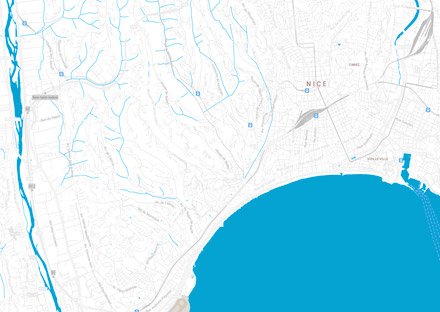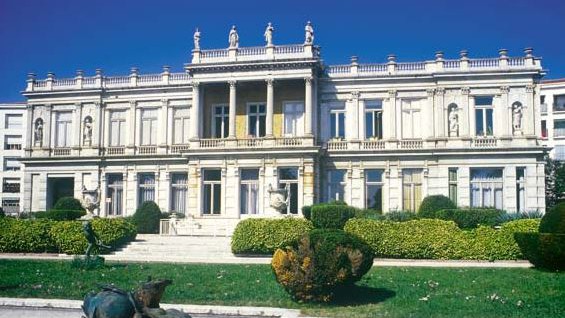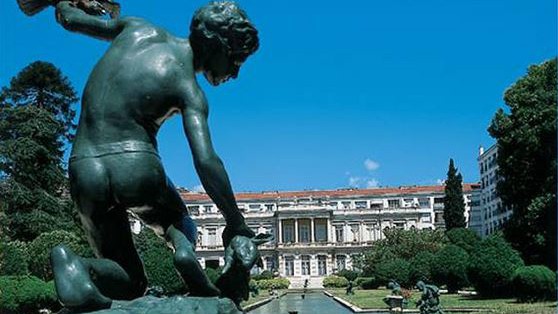A survivor of the real estate tidal wave of the 60s and 70s, the Marble Palace is a witness to the splendour of some of the Riviera's seasonal residences in the second half of the 19th century.
The history of its successive gardens allows us to decode what we see there today, because the building was built in a completely different plant environment and the regular flowerbed that accompanies it so well, was composed only half a century later.
Around 1840, a large traditional dwelling was built on this site by Honoré Gastaud, a banker from Nice, who wanted to surround it with a park of the new irregular style. Winding alleys ran through the space planted with subtropical essences, the two small towers still present had picturesque accents, a drip meandered in the slope on the side of the rising sun, reaching lower parts a huge glass-enclosed winter garden, now gone, stretched towards the belvedere terrace on two floors of artificial caves, still in place on the seaview side.
It was during this period that the planting of the great botanical species of the park, araucarias, eucalyptus and especially palms and cedars, were born, which later gave their names to the property, successively called "Villa Les Palmiers" and "The Great Cedars". This garden had such a reputation for beauty that during his stay in 1856 on the Riviera, tsarina Alexandra Féodorovna had wanted to visit it, and during the festivities of the attachment of the county of Nice to France, Napoleon III and Empress Eugenie were received there. The Gastaud bank went bankrupt in 1870. The estate for sale was acquired by Ernest Gambart, a art dealer. He needed a great framework to install his collections and showcase the works he offered to his clients. The transformation of the bastide into a villa "Les Palmiers" was entrusted to the Nice architect Sébastien-Marcel Biasini.
To an Italian Renaissance inspiration, it combined reminiscences of the French style in the 18th century. The cladding of the building required 27 loads of Carrara marble transported by sea, and the Niçois immediately named the building after it.
If the installation of the apartment buildings of the current condominium "The Great Cedars" does not get away with shocking visitors, it must be recognized that at the end of this "operation" the park has not been dismembered and that the whole that form the Palais de Marble (it is now assigned to the municipalarchives) and its floor is saved.
The Nice Côte d'Azur Archives service offers an online consultation on https://archives.nicecotedazur.org/
there
online is a written, graphic documentation fund
(plans) or iconographic (photographs, postcards, prints)
thousands of references on heritage.
architectural, urban planning, seaside tourism or even on the
carnival. This new site is both:
- A next-generation research tool in thearchives,
whether or not they are digitized, in accordance with site standards
European archives or libraries (the bases are already
referenced on the portal of the Ministry of Culture "
FranceArchives" and the European Archives Portal, and will be able to
soon to be integrated into the "Europeana" portal and the "Europeana"
Collections" of the Ministry of Culture). With a search
thematic or topographical, this tool was designed for the purpose of
audiences that need simplicity, intuitivity, tools
graphics and are used to search engines
Commercial.
- A showcase of the Archives' culturalaction,
with topics such as 'the expo of the moment', 'Nice Life of
"neighbourhoods," educational files, a background in honour, etc. the
site provides access to information on a variety of tools, such as
tablets and smartphones, regardless of their system
exploitation. Ergonomics designed to allow everyone to do so
access without difficulty.
This site is therefore intended to
to reach out to the research community around the world, to the curious
Nice's history and to the great

 StayHostel, ...
StayHostel, ... VisitMuseums, ...
VisitMuseums, ... Go outRestaurants, ...
Go outRestaurants, ... ShopsFashion, ...
ShopsFashion, ... LeisuresBeaches, sports, ...
LeisuresBeaches, sports, ... ServicesTourism, ...
ServicesTourism, ...











